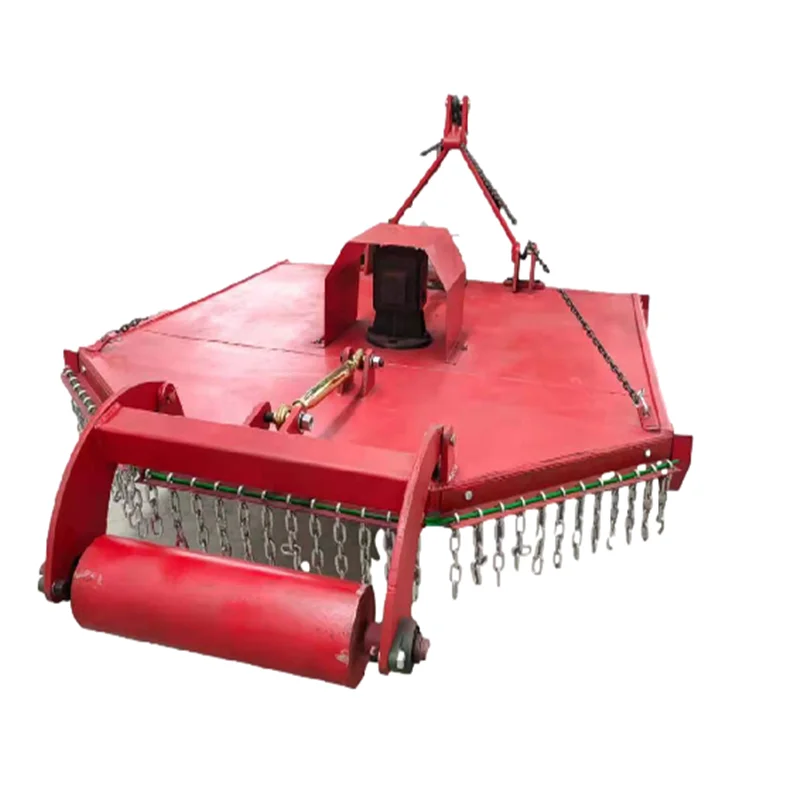Introducing the 3 point hitch flail mower for farm tractors ranging from 20-45hp. This high productivity agricultural machine offers a one-year warranty and is suitable for various industries. Despite its substantial weight of 430 KG, it boasts a cutting-edge gearbox as its core component. The mower is a new product for 2023 and comes with provided machinery test reports and video outgoing-inspection, ensuring its high-quality performance.
Advantages of Agricultural Rotary Mowers
Agricultural rotary mowers, also known as rotary cutters or brush hogs, offer several advantages in various agricultural applications.

- Versatility: Agricultural rotary mowers are highly versatile and can be used for various tasks such as cutting grass, weeds, brush, and even small trees. They can handle a wide range of vegetation types and thicknesses, making them suitable for different agricultural settings.
- Efficient Cutting: Rotary mowers use a spinning blade that cuts vegetation with a scissor-like action. This design allows for efficient cutting, even in dense or overgrown areas. The high-speed rotation of the blade ensures a clean and precise cut, reducing the need for multiple passes.
- Increased Productivity: Due to their efficiency, rotary mowers enable farmers and landowners to cover larger areas in less time. They are particularly useful for clearing pastures, maintaining roadsides, or managing overgrown areas. Increased productivity translates to cost savings and improved overall efficiency.
- Terrain Adaptability: Agricultural rotary mowers are designed to tackle various terrains, including uneven or rough surfaces. They can handle slopes, ditches, and other challenging landscapes. This adaptability makes them suitable for use in different agricultural environments, including fields, orchards, vineyards, and pastures.
- Vegetation Management: Rotary mowers are effective tools for vegetation management. By cutting and mulching the vegetation, they help control weed growth and promote a healthier pasture or field. The mulched vegetation acts as a natural mulch layer, which helps conserve soil moisture and reduce erosion.
- Easy to Operate: Rotary mowers are user-friendly and easy to operate. They typically attach to tractors or other vehicles using a three-point hitch or a power take-off (PTO) connection. Most models offer adjustable cutting heights, allowing operators to adapt to different vegetation types and mowing requirements.
Our company, with its extensive experience and expert team, specializes in the production of such high-performing and reliable agricultural rotary mowers.
Applications of Agricultural Rotary Mowers
Agricultural rotary mowers are widely used in various agricultural applications due to their versatility and efficiency. Here are some specific agricultural applications where rotary mowers are commonly employed:
- Field Mowing: Rotary mowers are extensively used for mowing fields, cutting down tall grasses, weeds, and other vegetation. This helps maintain clean and well-groomed fields, ensuring optimal growing conditions for crops.
- Pasture Management: Rotary mowers play a crucial role in pasture management. They are used to mow pastures, controlling weed growth and promoting the growth of desirable forage species. Regular mowing helps ensure a consistent and nutritious grazing environment for livestock.
- Orchard and Vineyard Maintenance: Rotary mowers are essential tools for orchard and vineyard maintenance. They are used to mow grass and weeds between tree rows or vine rows, reducing competition for nutrients and managing vegetation growth. This promotes healthier tree and vine growth and improves overall fruit quality.
- Roadside Maintenance: Rotary mowers are commonly employed for roadside maintenance, keeping road shoulders, medians, and ditches clear of vegetation. They help maintain clear visibility for drivers, prevent overgrowth that could obstruct traffic, and reduce fire hazards along roadways.
- Land Clearing and Brush Control: Rotary mowers are effective tools for land clearing and brush control. They can be used to clear small trees, shrubs, and thick brush, preparing the land for agricultural use or land development projects.
- Hay and Forage Production: Rotary mowers are widely used in the production of hay and forage crops. They are employed to cut down grasses, legumes, and other forage crops, allowing for faster drying and efficient baling or ensiling. After harvest, rotary mowers can be used to manage crop residue left in the field. They can effectively cut and chop crop stubble, incorporating it into the soil to enhance organic matter content and nutrient cycling.
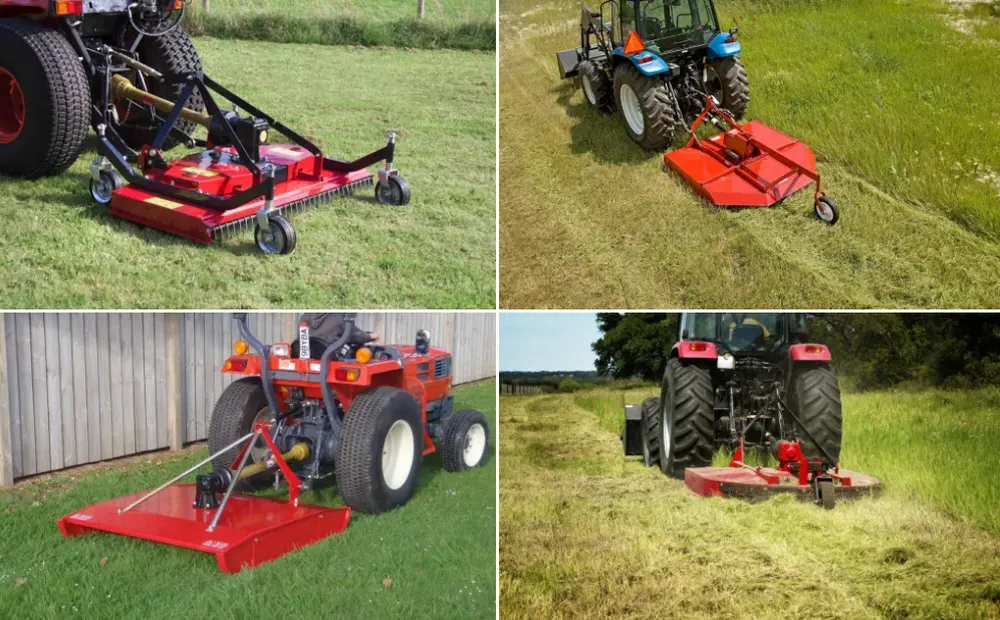
How Does the Agricultural Rotary Mower Work?
An agricultural rotary mower is a machine used for cutting grass, weeds, and other vegetation in agricultural fields, pastures, and roadside areas. It typically consists of a rotating blade or blades that cut the vegetation at a desired height. Here's a general overview of how an agricultural rotary mower works:
- Power source: Agricultural rotary mowers are usually powered by a tractor's power take-off (PTO) shaft. The PTO transfers mechanical power from the tractor to the mower.
- Attachment: The mower is attached to the tractor's PTO using a driveline, which transfers power from the tractor to the mower's cutting mechanism.
- Cutting mechanism: The cutting mechanism of a rotary mower typically consists of a horizontal shaft with multiple cutting blades attached to it. The number of blades can vary depending on the model and design of the mower.
- Rotation: When the PTO is engaged, it transfers power to the mower's cutting mechanism, causing the blades to rotate at a high speed. The blades are designed to create a cutting action as they spin.
- Cutting action: As the mower is moved across the field or area to be mowed, the rotating blades make contact with the vegetation. The blades slice through the grass or weeds, cutting them at the desired height. The height can often be adjusted by raising or lowering the mower's wheels or skids.
- Discharge: As the vegetation is cut, it is typically discharged from the mower through an opening at the rear or side. Some mowers have a built-in chute or deflector that directs the cut material to one side, while others may have a collection system to gather the cut vegetation.
- Safety features: Agricultural rotary mowers often include safety features such as guards or shields that cover the rotating blades to prevent debris from being thrown out and protect the operator and surrounding areas.
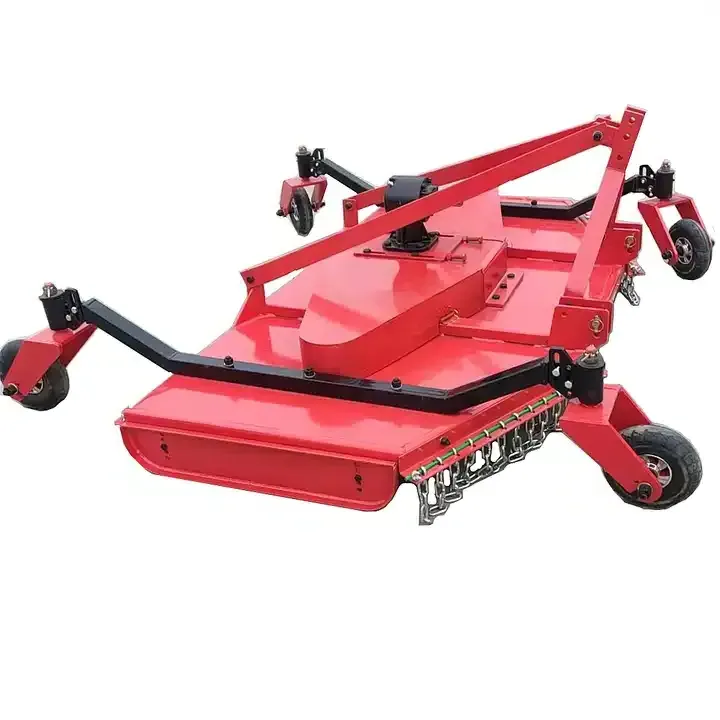
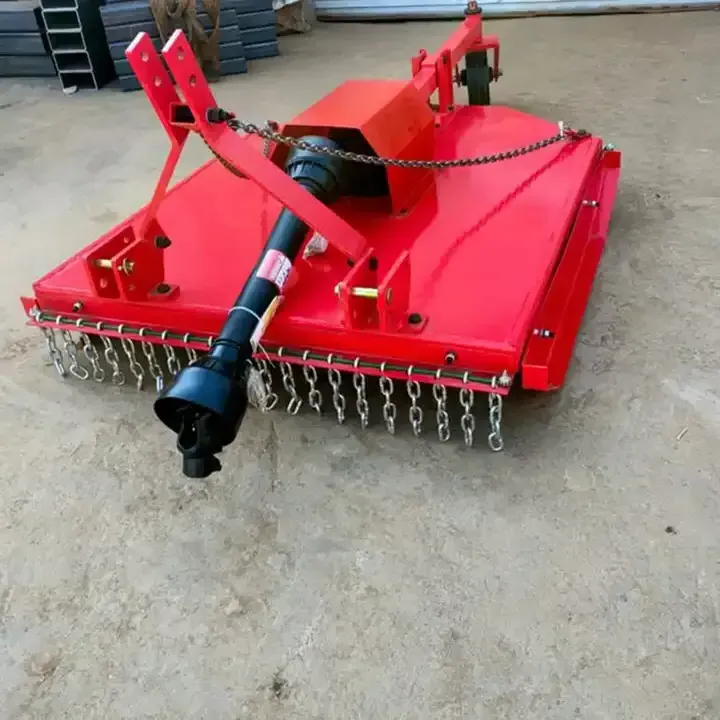
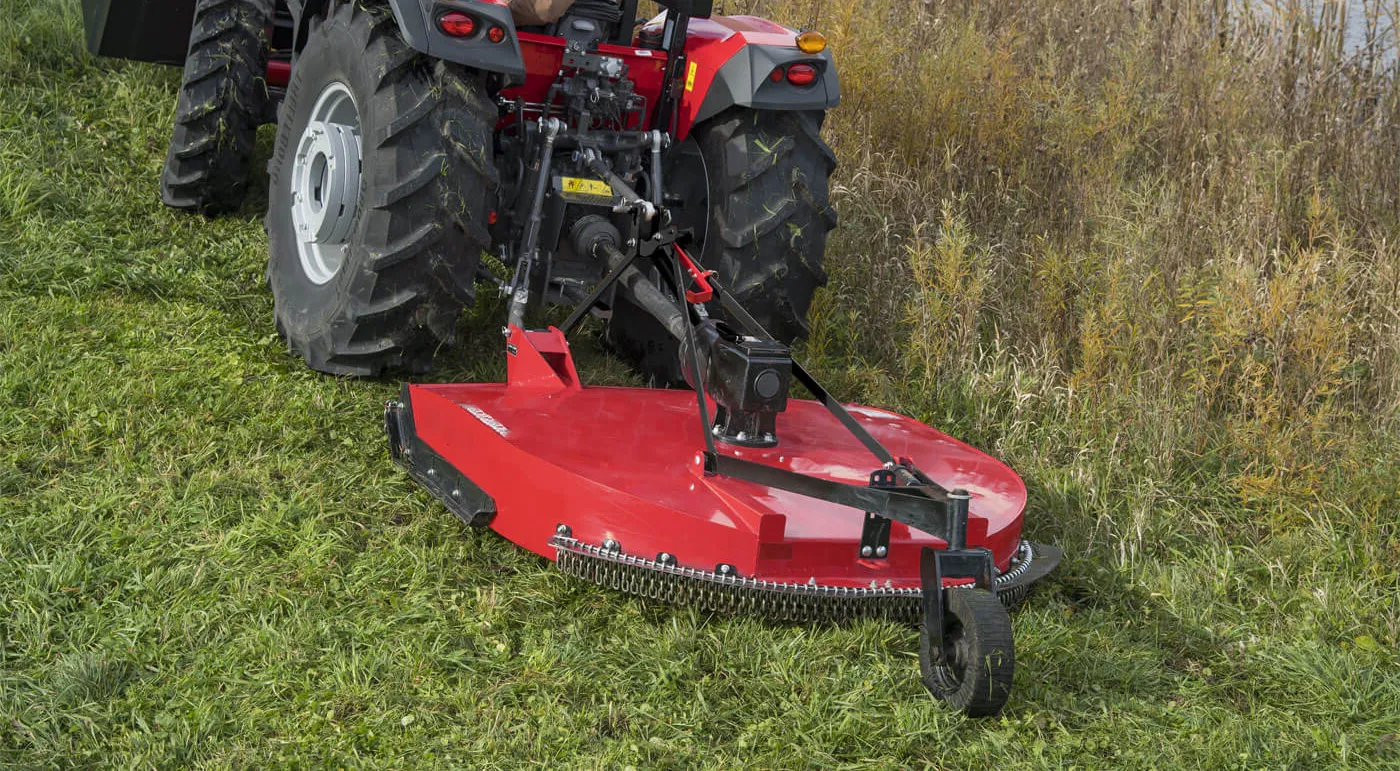
Choosing the Right Agricultural Rotary Mower for Your Tractor
Choosing the right agricultural rotary mower for your tractor involves considering several factors to ensure it meets your specific needs and requirements. Here are some essential considerations to help guide you in selecting the appropriate rotary mower:
- Mower Type: Rotary mowers come in various types, such as rear-mounted, side-mounted, or front-mounted. Consider the layout of your land, the tasks you need to perform, and your tractor's capabilities to determine the most suitable mower type for your needs.
- Cutting Width: The cutting width refers to the width of the mower's cutting deck. It determines how much area the mower can cover in a single pass. Consider the size of your land and the efficiency you desire to select an appropriate cutting width. Larger cutting widths are beneficial for larger fields, while smaller widths are suitable for smaller or irregularly shaped areas.
- Power Requirements: Ensure that the rotary mower you choose is compatible with the power output of your tractor. Check the power requirements of the mower, including the necessary PTO (power take-off) horsepower, to ensure your tractor can provide sufficient power for optimal performance.
- Durability and Build Quality: Look for a rotary mower that is built with sturdy materials and has a reputation for durability. Consider factors such as the thickness of the deck, the quality of the blades, and the overall construction to ensure the mower can withstand the demands of your agricultural tasks.
- Height Adjustment and Cutting Height Range: Different agricultural applications may require varying cutting heights. Ensure the rotary mower you select offers adjustable cutting heights within a range that suits your needs. This flexibility allows you to adapt to different conditions and achieve desired grass or crop heights.
Key Maintenance Practices for Agricultural Rotary Mowers
Proper maintenance and lubrication are essential for keeping your agricultural rotary mower in good working condition and maximizing its lifespan. Here are some key maintenance and lubrication practices to follow:
- Read the Manual: Start by thoroughly reading the manufacturer's manual that comes with your rotary mower. It will provide specific instructions and recommendations for maintenance and lubrication based on the model you own.
- Regular Cleaning: After each use, clean the mower to remove any debris, grass clippings, or other materials that may have accumulated. Use a brush or compressed air to clean hard-to-reach areas. This prevents buildup and potential damage to the mower's components.
- Blade Maintenance: Check the condition of the blades regularly. Sharpen or replace them as needed to ensure a clean and efficient cut. Dull blades can strain the mower and result in uneven cutting or damage to the grass or crops.
- Lubrication Points: Identify the lubrication points on your rotary mower as indicated in the manual. Apply lubricating oil or grease to these points to reduce friction and wear. Common lubrication points include the spindles, gearbox, and PTO shaft.
- Safety Check: Inspect all safety features of the rotary mower, such as guards and shields, to ensure they are in good condition and functioning correctly. Replace any damaged or missing safety components to prevent accidents and injuries.
- Storage: When storing the rotary mower for an extended period, clean it thoroughly, and apply a protective coating to prevent rust and corrosion. Store it in a dry and covered area to protect it from the elements.
Why Choose AGKNX's Agricultural Rotary Mower?
AGKNX Agricultural Machinery Co., Ltd. has been engaged in the research and development of agricultural machinery, such as rotary tillers, PTO shafts, sickle bar mower, rotary mower, flail mower, boom sprayers, fertilizer spreaders, furrow ploughs, potato planters, disc harrows, disc ploughs, disc blades, plough blades, agricultural cultivators, land levelers, potato harvester, agricultural trailers, corn seeder, wheat seeder, vegetable seeder, harvest machines, post hole digger, wheat seeders, corn seeders, agricultural subsoiler, and soil-loosening shovels. Our company has more than 100 employees, among which there are 20 technical technical staff and five senior R&D personnel.
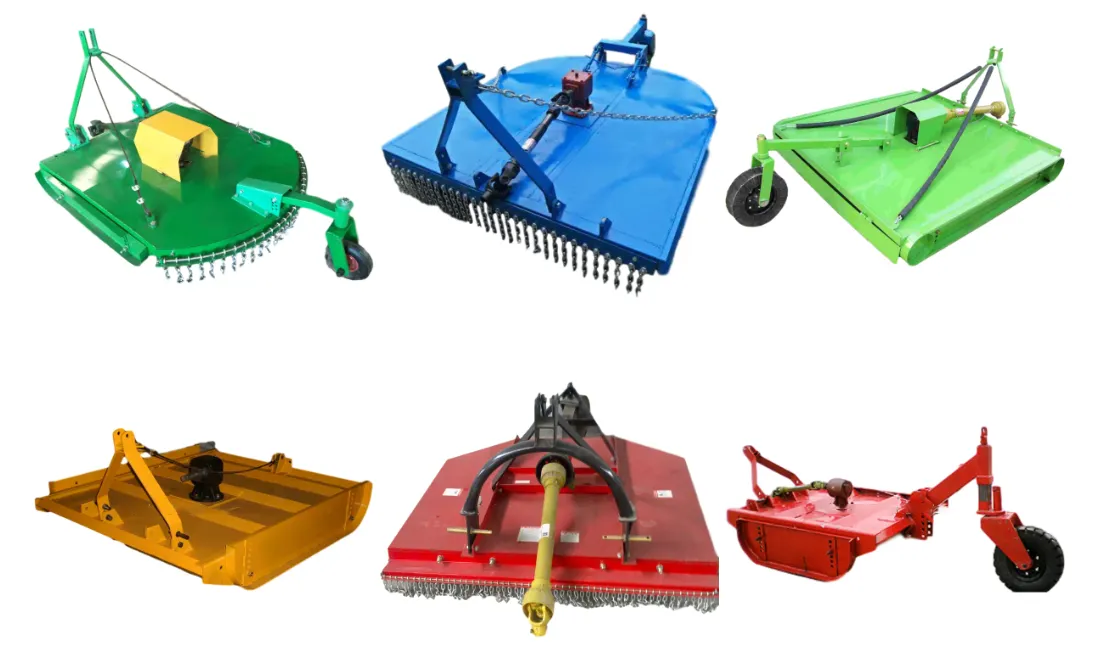
With over 10 years experience in the industry, our products are sold all over the country and are exported to many countries and regions in Europe, America, Africa, the Middle East, and Southeast Asia. We ensure the highest quality of our products through rigorous testing and inspection. Our commitment to quality is demonstrated by our certifications and our dedication to customer satisfaction.
We offer a range of services including custom design, expert consultation, and superior after-sales service. Our company's mission is to provide reliable and innovative agricultural machinery to support the needs of farmers worldwide. We welcome inquiries and look forward to assisting you with your agricultural needs.
Author: Yjx

